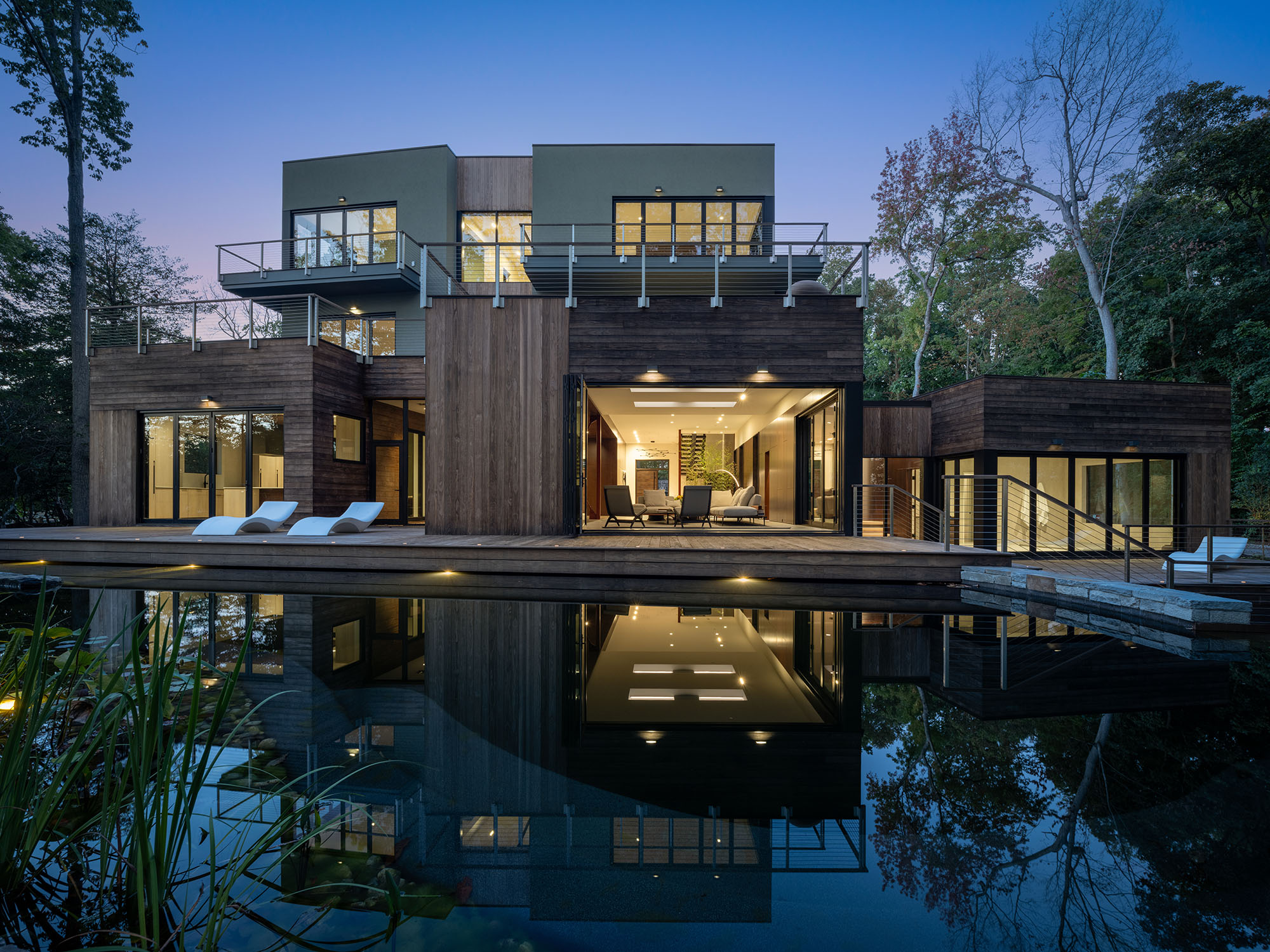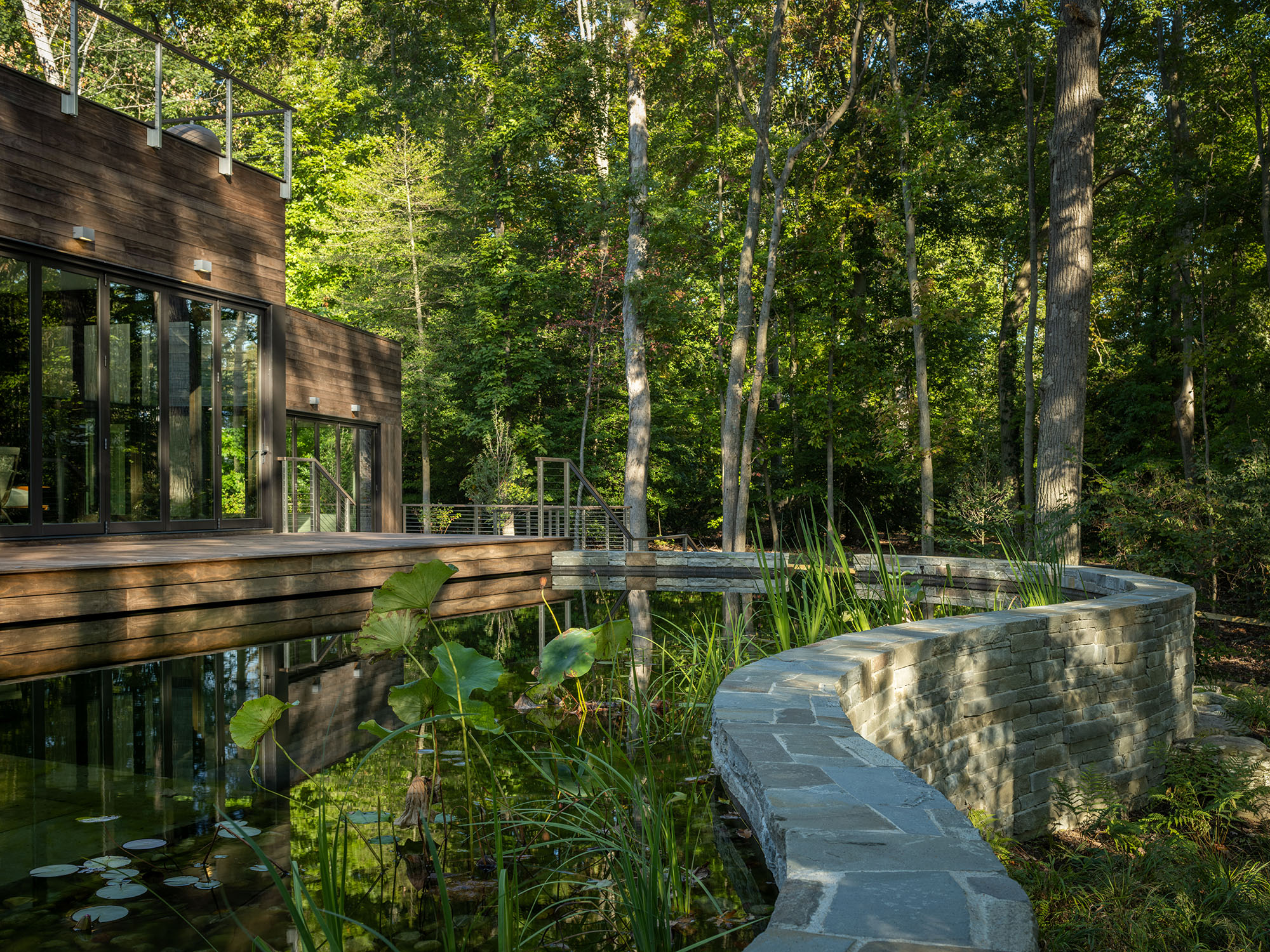- © 2025 Annapolis Home Magazine
- All Rights Reserved
Part 1: The Home
By Robert Haywood
Photography by John Cole

This distinctive Annapolis home, with its minimalist, elemental forms, fulfills the homeowner’s desire for a residence with a strong connection to the natural environment. This is a common goal of waterfront homeowners, but this home goes much further. It’s not just the water views that matter but the lush foliage and tall trees on the outer perimeter of the home, which is a forest conservation zone.
We don’t usually talk about architecture as representational, but architect Amy Gardner refers to this modern home as a “representation of the forest.” What does this mean? Representation is an image or form that denotes something outside or beyond the specific form itself. In this case, the representation is not literal but abstract. Here, representation refers not just to a single tree but to the dense forest of oaks, maples, American Beech, sweetgum, and Black Tupelo trees that surround the structure, always changing shape and color with the seasons. Our admiration and need for nature have a long history, as expressed by writers such as 19th-century ecological and naturalist writer Henry David Thoreau, who insisted that “In society, you will not find health, but in nature.” He was referring to the healing power of nature while always insisting on nature’s preservation.
The homeowner brought in a Feng Shui consultant who reinforced the design’s connection to nature, including the orientation of the architecture. Feng Shui—meaning “the way of the wind and water”—is an ancient Chinese practice of arranging spaces to maximize balance and harmony. Harmony does not require symmetry, as evidenced by the two largest rectangular volumes that make up the three main parts of the house and are positioned asymmetrically. Gardner and her design partner, Brittany Williams, explain it this way: “The three volumes (west volume, east volume, and spa pavilion) splay open towards the South. The splay allows us to expand access to light and view.”
This 8,500-square-foot home is taller than the average home, with three floors lifting upward; each floor offers different views of the forest. The home reaches 43.6 feet tall, near the maximum height allowed in this zone. Lacreisha Phillips, landscape architect at Campion Hruby Landscape Architects, notes that the trees that were preserved on all sides act as “a cocoon for the house.”
The wood and stucco exterior complements the surrounding forest. The stucco is painted a soft green, “Carolina Gull” (Benjamin Moore). The vertical bands of wood on the exterior are made more visually interesting by the horizontal bands at the top. Gardner and Williams think of the vertical cladding as echoing trunks in contrast to the horizontal branches.
According to David Carlisle, president of Bayview Builders, the exterior Kebony cladding, a treated pine, is more resistant to rot and more environmentally sensitive than tropical hardwoods. Like a living thing, the Kebony changes color and grays over time. Each side of the home will take on its own shade, depending on its exposure to the sun and elements.
The forest theme is reinforced by visible green roofs covered with plantings. The verticality of the main house is balanced horizontally by a long covered walkway leading to the garage. The walkway’s green roof, visible from the upper floors of the home, introduces another layer of foliage to the project. Another green roof rests over a spa pavilion on the south side, where you can look out at a biopool and forest. When standing on the second-floor balcony, you look down on the plantings rather than on a flat roof.
Typically, a green roof can reduce the temperature of the roof’s surface and contribute to stormwater management. Living roofs require some maintenance, including weeding, but visually, they are effective in offsetting hard surfaces with softer, textured vegetation.
In keeping with the focus on nature, water elements enrich the overall design, including a circular fountain pool, eight feet in diameter, in the north courtyard near the main entrance, and, on the south side, a biopool with a waterfall. The fountain, the curvilinear biopool, and the wavy beds of stones for stormwater management along the sides of the house contrast with the geometric form of the house so that nothing ever feels static. The landscape architecture is visually and aurally meditative and designed by CHLA as a “sequence of connections to water elements, from the fountain to the hot tub to the biopool to the views of Whitehall Bay,” Gardner explains.
The interior design by ColePrévost is clean, open, and elegant, and, like the exterior, minimal in design. The “metaphorical garden” sitting area near the entrance is a special interior design moment. A contemporary black sofa with a big swerve is staged with three large seating stones arranged in front of it. The stones are manufactured ceramic and connect the artifice of interior design with the natural world.
On the ceiling at the far end of this spacious living area or solarium are skylights (walkable on the deck above), casting natural light across the room. The kitchen and adjoining dining room all complement the home’s aesthetic. A flowing floor plan creates harmony with the architecture. Such an overall coherence between architecture and interior design is not always achieved in residential projects.
On the third floor, which houses the primary bedroom suite and includes a meditation room, you are surrounded by the tree canopy. When two walls of retractable glass slide back and almost vanish, the bedroom becomes an extraordinary open-air oasis. Here is where forest and structure merge. Especially at night, one can sense the forest’s invisible forces expressed in rustling leaves, the movements of nocturnal foragers, and the songs of night-flying birds.
For all the references to nature, this home, as with all homes, is as much an intervention in nature as it is an embrace. The home pays homage to the environment and, at the same time, asserts itself as an independent form that remakes and claims its own space. When you look up at trees, you can only see and feel wonder, even if their branches are broken. This superbly crafted home invites its own kind of awe—a new human-made sanctuary has taken its place in the forest.
Part 2: The Biopool
By Kymberly Taylor

This biopool is an extension of the home’s architecture, countering its rectilinear forms with a sinuous natural curve. “The house is very architectonic; it’s all straight lines. The idea was that every inch you move away from the house, the project starts to loosen up and blend back into nature,” says Kevin Campion of Campion Hruby Landscape Architects.
“Blending back into nature” is accurate, for the biopool, with its waterlilies and lush aquatic grasses, is a miniature ecosystem and habitat for wildlife. Chlorine and chemicals do not clean the water. Rather, aquatic plants and microorganisms do the hard work of oxygenating the water, breaking down pollutants and organic matter, and preventing the growth of algae.
There are many ways to design and build a biopool. In this case, the pool is composed of a concrete shell protected by an inner membrane. A shelf on one edge of the pool, separate from the swimming area, is filled with gravel and planted with a careful balance of submerged, semi-submerged, and floating aquatic plants, selected with the guidance of aquatic consultant Kelly Billing, founder of Water Becomes a Garden.
Lacreisha Phillips, an associate at Campion Hruby, explains that a pump circulates water from the swimming area through the plantings and then back into the pool. A sleek metal waterfall channels water down into a second, smaller pool, creating soothing sounds. The water remains clean and refreshing and feels much like swimming in a freshwater lake, she says. There are no fish, but frogs, butterflies, and water spiders may be frequent visitors.
In fact, about three days after they had finished the pool, her team noticed that a couple of frogs had moved in. “They didn’t waste any time. We saw some frogs and animals a few days after the water went in, and we were like, ‘I guess they approve.’ ”
Swimming alongside nature is not for everyone. “I think subconsciously, we all know that the closer to nature we are, the better we are in terms of like health, as well as physically and mentally. But there’s still some kind of aversion to it. It’s the reason we have to form houses to kind of protect ourselves from it,” Phillips notes.
However, communing with pond life makes perfect sense for the homeowner, who is from Trinidad and practices Hinduism. Hindus worship the natural world, including grasses, shrubs, trees, and insects. Rivers are especially sacred because they nourish and purify not only the body and mind but the inner being. Before his home was built, he lay down in the creek in front of his property, meditating as the water and fish swirled and swam over him. He told Phillips and Campion that, as a child growing up and swimming in the Caribbean, this practice was quite common. “When we heard he did that, we thought, ‘You need a biopool.’ We had always wanted to do one and we thought it fit his personality, how he lives in communion with the land,” says Campion.
Phillips, Campion, and architect Amy Gardner note how fortunate they were to work with the client, who invited a Hindu priest to the house to perform a ceremonial blessing. “He understood how critical it was to understand the whole picture, not just of the house but the outside space,” reflects Phillips. There is a powerful synergism at work here between architecture and landscape, earth and water, creative team, and mindful client.
ARCHITECTURE: Amy Gardner, FAIA LEED-AP, and Brittany Williams, AIA LEED-AP, Gardner Architects, Silver Spring, Maryland. BUILDER: David Carlisle, President, and Neil Thompson, Construction Manager, Bayview Builders, Annapolis, Maryland. LANDSCAPE ARCHITECTURE: Kevin Campion, Principal, and Lacreisha Phillips, Associate, Campion Hruby Landscape Architects, Annapolis, Maryland. INTERIOR DESIGNER: Stephanie Prévost, ColePrévost, Washington, DC. KITCHEN DESIGNER: Jennifer Gilmer Kitchen & Bath.
Structural Engineer – Cobb Architectural Engineers, LLC
Civil Engineer – Charles P. Johnson & Associates
Feng Shui Consultant – Will LeStrange
Pool Construction & Consultation – Ben Herr and South Fork Studio Landscape Architecture
Biopool Plantings & Aquatic Consultant – Kelly Billing, owner of Water Becomes a Garden
Skylights – TW Perry
Millwork and Casework – Hamilton Ross Millwork
Tile – Corona Tile and Fantasy Tile
Countertop – In Home Stone
Metal Fabrication & Fireplace Fabrication – David Fields Welding and Fabrication
Fireplace – Bay Stoves
Landscape/Site Subcontractor – Planted Earth
Doors & Windows – Loewen, The Sanders Company
Wood Flooring – Wellborn + Wright
Home Security – Petitbon Alarm Company
Appliances – ADU and ABW
Special thanks to Chris Newman, Vice-President, Bayview Builders, for his assistance.
© Annapolis Home Magazine
Vol. 15, No. 6 2024